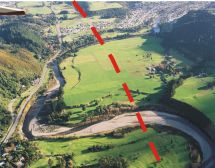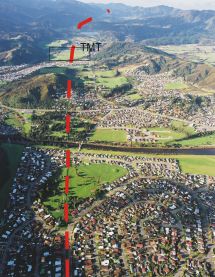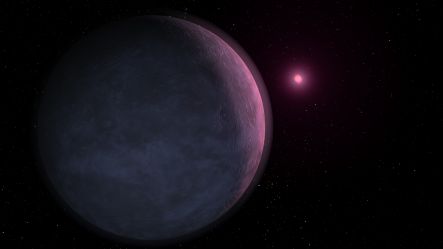Our Changing World for Thursday 19 June 2008
On This Programme
A major seismological and engineering project named 'It's Our Fault', is studying the Wellington Fault, trying to pinpoint the areas that will be most affected in the next earthquake. Geologists Russ Van Dissen and Rob Langridge of GNS Science are working on the project, looking at how understanding historical earthquakes can help us plan for future ones. They took Dacia Herbulock to Te Marua in the Hutt Valley to look at a unique section of the fault.


An aerial view of the fault line in Hutt Valley. Images from GNS Science.
The smallest star on record to have an orbiting planet, 3000 light years away, has recently been discovered. The star, the planet's equivalent of our Sun, is so small that it may be incapable of producing energy by nuclear reactions. The planet is slightly larger than Earth but has a smaller orbital radius, similar to Venus. Due to the small size of the star, the orbiting planet is likely to be colder than Pluto. Veronika Meduna met with Phil Yock, at the University of Auckland, and Ian Bond, at Massey University to discuss the discovery.

Artist's conception pictures of the new planetary system by Kevin Lane and Randy Jackson of the Jet Propulsion Laboratory, California. The "brown dwarf" star would likely be magenta in colour, and provide only feeble illumination of its orbiting planet.
Check out also: www.phys.canterbury.ac.nz/research/mt_john/index.shtml
Many books about gender differences claim that male and female brains are hard-wired in different ways, and that such differences account for all manner of social and personal difficulties - from the exhaustion of working mothers to the boy who won't read novels or clean the toilet. Cordelia Fine, a psychologist based at the Centre for Applied Philosophy and Public Ethics at the University of Melbourne, says a surprising amount of what we are told about our brains is misinterpreted, just plain wrong and used as an excuse to justify traditional gender roles. She tells Veronika Meduna that such stereotypes stop people from negotiating new arrangements to deal with domestic duties and may hold people back from reaching their potential.
Cordelia Fine is a keynote speaker at the New Zealand International Science Festival in Dunedin in July.
Collaborators from physics, chemistry and the biological sciences are working on a new way to improve cancer detection. Researchers from the MacDiarmid and Malaghan Institutes at Victoria University are developing a new type of magnetically-charged nanoparticle that will target cancer cells in the body. These highly-magnetic particles will bind to cancer cells, making even the smallest tumours more clearly visible on an MRI scan. The hope is that this will lead to earlier detection and increase the odds of survival. Dacia Herbulock visited the labs of several of the scientists involved in the project, including Richard Tilley, Peter Ferguson, Ian Hermans and Kirk Feindel.
